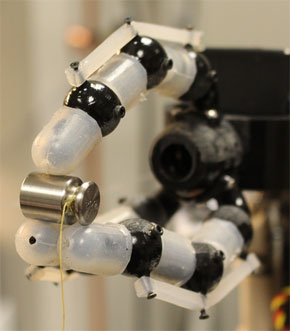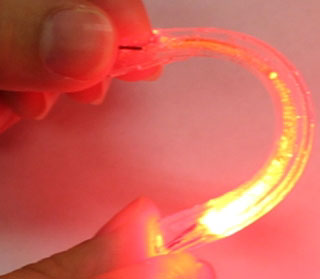
Fiber Sensors Improve Robot Touch Sensitivity
Fiber optic sensors could give robots the sensitivity needed to handle delicate objects and work safely alongside humans.
A three-fingered, soft robotic hand features 14 embedded fiber optic strain sensors that enable the hand to determine where its fingertips are in contact and to detect forces of less than a tenth of a newton.

A robotic hand features 14 embedded fiber Bragg grating sensors, allowing it to determine where its fingertips are in contact and to detect forces of less than a tenth of a newton. Courtesy of Carnegie Mellon University.
Meanwhile, a new stretchable optical sensing material (which was not incorporated in this version of the hand) could be used in a soft robotic skin to provide even more feedback.
"If you want robots to work autonomously and to react safely to unexpected forces in everyday environments, you need robotic hands that have more sensors than is typical today," said Yong-Lae Park, an assistant professor of robotics at Carnegie Mellon University who led the project.
"Human skin contains thousands of tactile sensory units only in the fingertip, and a spider has hundreds of mechanoreceptors on each leg, but even a state-of-the-art humanoid such as NASA's Robonaut has only 42 sensors in its hand and wrist," Park said.
The robotic hand was developed in cooperation with Intelligent Fiber Optic Systems Corp. of Santa Clara, Calif., and with support from NASA. It incorporates commercially available fiber Bragg grating sensors, which detect strain by measuring shifts in the wavelength of light propagating through optical fiber.
Conventional pressure or force sensors are problematic because their wiring can be complicated, prone to breaking and susceptible to electromagnetic interference. Optical fiber, on the other hand, is immune to this interference, and one strand can contain several sensors. All of the sensors in each of the fingers of the robotic hand are connected with four fibers, although, theoretically, a single fiber could do the job, Park said.
Despite their advantages, conventional fiber optic sensors don't stretch much. Glass fibers stretch hardly at all, and even polymer fibers stretch typically only 20 to 25 percent, Park said. That is a limiting factor in a device such as a hand, where a wide range of motion is essential.

Fiber optic sensors made from flexible, stretchable silicone rubber could give robots even greater sensitivity. Courtesy of Carnegie Mellon University.
Future versions of the hand could be made even more sensitive with artificial skin that incorporates stretchable fiber sensors based on commercially available silicone rubber. Also developed in Park's lab, these soft waveguides are lined with reflective gold; as the silicone is stretched, cracks develop in the reflective layer, allowing light to escape. By measuring the loss of light, the researchers are able to calculate strain or other deformations.
Industrial robots, working in a controlled environment where people aren't present, are capable of extremely precise manipulation with only limited sensors. But as roboticists work to develop soft robots that can interact routinely and safely with humans, increased attention to tactile and force sensing is essential, Park said.
The work will be presented at the IEEE International Conference on Intelligent Robots and Systems this week in Hamburg, Germany.
Published: September 2015